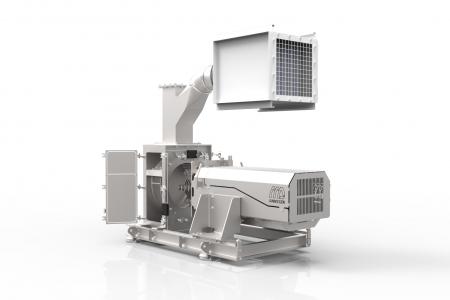This article discusses:
- The difference between milling and grinding of powders and granules
- Which powers you need for milling and grinding
The experts at Dinnissen Process Technology are available to answer all your questions:
Get in touch with Juul Jenneskens 077 467 3555
Discover the differences between milling and grinding
Various operations are required for the preparation of powders. One of these operations is to convert larger grains into smaller particles. The industry uses various types of machines for this. The two English terms milling and grinding are common in these types of operations and are often used interchangeably.
Milling is equivalent to grinding and originally is the process of converting granular materials into smaller pieces by means of compressive force. Examples are the conversion of grain into flour and the transformation of peppercorns into pepper powder. This was done by pulverizing granules on an annular surface, by means of heavy revolving stone wheels. Initially, the stones were driven with the help of horses that supplied the energy for this in a treadmill. Soon there were windmills and watermills that powered the pumping station.
Grinding stands for crushing and, like milling, involves the conversion of grains into smaller pieces or powder. Unlike milling, no compressive forces are used, but shear forces in combination with compressive force. In grinding, the grains are located in a narrow annular opening. At the inlet, where the grains enter the grinding mechanism, the annular opening is so large that the grains fit in completely. The annular opening narrows downwards. Both the inner and outer wall are provided with grooves that exert resistance to the grains. As soon as the inner wall of the opening starts to rotate, the grains in the opening set in motion and are thereby subjected to shearing. This will break the grains into smaller pieces. The broken pieces sink further and further and are broken again and again. Examples of this mechanism are a traditional coffee grinder or a pepper grinder.
Reducing particles in size
Milling and grinding are primarily used to reduce the dimensions of grains and chunks of material. With milling and grinding machines intended for this, a reduction to 20 microns is possible. In addition to shredding the grains, the mechanism is also used for:
- Increasing the surface area of the particles,
- Producing particles of a desired size,
- Pulverizing the material or resources.
The following forces in particular occur during milling and grinding of grains and lumps of material:
- Impulse forces
- Compressive forces
- Shear forces
Which force or combination of forces can best be used to shred the grains, depends on the properties of the material to be shredded. The fragility of the product, the moisture and heat resistance in particular determine the effectiveness of milling and grinding.

Dinnissen hammer mill
Formulas
There are three formulas to calculate how much energy it takes to shrink particles in size. It depends on the properties of the grains and on the grinding method which formula gives the best approximation.
It concerns the following three formulas:
Kick's law
This formula is best suited for coarse grinding (d1 / d2 <8). Kick's law indicates that the energy required is proportional to the logarithm of the ratio of the original diameter of the particles to the diameter of the broken particles.
Bond’s law
This formula is best suited for medium grinding (8 <d1 / d2 <100) and indicates that the energy required is proportional to the square root of the surface-volume ratio.
Rittinger’s law
This formula gives the better results with fine grinding (d1 / d2> 100). Rittinger's law indicates that the energy required is proportional to the change in surface area of the product.

Dinnox mill
Various operations are necessary for the production of powders. One of these operations is to convert larger grains into smaller particles

Name: Juul Jenneskens
Advisor
Please feel free to contact me if you have any questions about this subject. My team of colleagues and I are ready to answer!
Get in touch with Juul Jenneskens 077 467 3555 [email protected]
Do you prefer to request a consultation directly?
